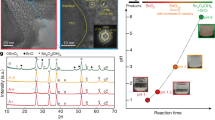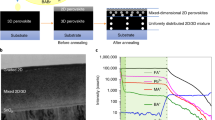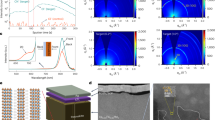Abstract
Modifying the exposed upper surface of perovskite solar cells (PSCs) has greatly contributed to improving their photovoltaic performance. The equally important buried interface (that is, the hidden bottom of perovskite film and the beginning of perovskite film crystallization) is much less studied due to great difficulties in tailoring it. Here we expose the large-area buried interface non-destructively for direct investigation. We find that the disordered beginning of the perovskite film growth deteriorates the buried interface. To address this issue, instead of using a passivator, we synthesize a transparent and conductive oxide perovskite (SrSnO3) to act as the electron transport layer. The high lattice matching enables a more ordered beginning of the growth of halide perovskite on the electron transport layer, avoiding the formation of a deteriorated buried interface. The constructed buried interface exhibits suppressed defects, strain, better crystallinity, reduced ion migration and fewer voids. The best performing PSCs deliver a power conversion efficiency of 25.17%. Moreover, PSCs with an initial power conversion efficiency of 24.4% maintain 90% of the original value after operating for 1,000 h.
This is a preview of subscription content, access via your institution
Access options
Access Nature and 54 other Nature Portfolio journals
Get Nature+, our best-value online-access subscription
$29.99 / 30 days
cancel any time
Subscribe to this journal
Receive 12 print issues and online access
$209.00 per year
only $17.42 per issue
Buy this article
- Purchase on Springer Link
- Instant access to full article PDF
Prices may be subject to local taxes which are calculated during checkout






Similar content being viewed by others
Data availability
All the data supporting the findings of this study are available within this article and its Supplementary Information. Any additional information can be obtained from corresponding authors on reasonable request. Source Data are provided with this paper.
References
Azmi, R. et al. Damp heat-stable perovskite solar cells with tailored-dimensionality 2D/3D heterojunctions. Science 376, 73–77 (2022).
Kim, M. et al. Conformal quantum dot-SnO2 layers as electron transporters for efficient perovskite solar cells. Science 375, 302–306 (2022).
Jeong, J. et al. Pseudo-halide anion engineering for alpha-FAPbI3 perovskite solar cells. Nature 592, 381–385 (2021).
Jeong, M. et al. Large-area perovskite solar cells employing spiro-Naph hole transport material. Nat. Photon. 16, 119–125 (2022).
Tong, J. H. et al. Carrier control in Sn-Pb perovskites via 2D cation engineering for all-perovskite tandem solar cells with improved efficiency and stability. Nat. Energy 7, 642–651 (2022).
Liu, X. et al. Perovskite solar cells based on spiro-OMeTAD stabilized with an alkylthiol additive. Nat. Photon. 17, 96–105 (2023).
Jeong, M. J. et al. Boosting radiation of stacked halide layer for perovskite solar cells with efficiency over 25%. Joule 7, 112–127 (2022).
Tan, S. et al. Stability-limiting heterointerfaces of perovskite photovoltaics. Nature 605, 268–273 (2022).
Degani, M. et al. 23.7% efficient inverted perovskite solar cells by dual interfacial modification. Sci. Adv. 7, abj7930 (2021).
Ni, Z. Y. et al. Resolving spatial and energetic distributions of trap states in metal halide perovskite solar cells. Science 367, 1352–1358 (2020).
Chen, H. et al. Regulating surface potential maximizes voltage in all-perovskite tandems. Nature 613, 676–681 (2022).
Luo, C., Zhao, Y., Wang, X. J., Gao, F. & Zhao, Q. Self-induced type-I band alignment at surface grain boundaries for highly efficient and stable perovskite solar cells. Adv. Mater. 33, 2103231 (2021).
Chen, H. et al. Quantum-size-tuned heterostructures enable efficient and stable inverted perovskite solar cells. Nat. Photonics 16, 352–358 (2022).
Jiang, Q. et al. Surface reaction for efficient and stable inverted perovskite solar cells. Nature 611, 278–283 (2022).
Jiang, Q. et al. Surface passivation of perovskite film for efficient solar cells. Nat. Photon. 13, 460–466 (2019).
Sutanto, A. A. et al. 2D/3D Perovskite engineering eliminates interfacial recombination losses in hybrid perovskite solar cells. Chem 7, 1903–1916 (2021).
Yang, X. Y. et al. Buried interfaces in halide perovskite photovoltaics. Adv. Mater. 33, 2006435 (2021).
Wu, S. F. et al. Modulation of defects and interfaces through alkylammonium interlayer for efficient inverted perovskite solar cells. Joule 4, 1248–1262 (2020).
Levine, I. et al. Charge transfer rates and electron trapping at buried interfaces of perovskite solar cells. Joule 5, 2915–2933 (2021).
Qin, Z. X. et al. Zwitterion-functionalized SnO2 substrate induced sequential deposition of black-phase FAPbI3 with rearranged PbI2 residue. Adv. Mater. 34, 2203143 (2022).
Xiong, Z. et al. Simultaneous interfacial modification and crystallization control by biguanide hydrochloride for stable perovskite solar cells with PCE of 24.4%. Adv. Mater. 34, 2106118 (2022).
Dong, Y. et al. Chlorobenzenesulfonic potassium salts as the efficient multifunctional passivator for the buried interface in regular perovskite solar cells. Adv. Energy Mater. 12, 2200417 (2022).
Liu, T. R. et al. Improved absorber phase stability, performance, and lifetime in inorganic perovskite solar cells with alkyltrimethoxysilane strain-release layers at the perovskite/TiO2 interface. ACS Energy Lett. 10, 3531–3538 (2022).
Dou, J. et al. Synergistic effects of Eu-MOF on perovskite solar cells with improved stability. Adv. Mater. 33, 2102947 (2021).
Meng, W. et al. Revealing the strain-associated physical mechanisms impacting the performance and stability of perovskite solar cells. Joule 6, 458–475 (2022).
Chen, S. S. et al. Stabilizing perovskite-substrate interfaces for high-performance perovskite modules. Science 373, 902–907 (2021).
Lee, J. H. et al. Interfacial α-FAPbI3 phase stabilization by reducing oxygen vacancies in SnO2−x. Joule 7, 380–397 (2023).
Lin, Y. Z. et al. Revealing defective nanostructured surfaces and their impact on the intrinsic stability of hybrid perovskites. Energy Environ. Sci. 14, 1563–1572 (2021).
Chen, S. S. et al. Identifying the soft nature of defective perovskite surface layer and its removal using a facile mechanical approach. Joule 4, 2661–2674 (2020).
Zhang, Q. et al. α-BaF2 nanoparticle substrate-enabled γ-CsPbI3 heteroepitaxial growth for efficient and bright deep-red light-emitting diodes. J. Am. Chem. Soc. 144, 8162–8170 (2022).
Zhang, J. Q. et al. Elimination of interfacial lattice mismatch and detrimental reaction by self-assembled layer dual-passivation for efficient and stable inverted perovskite solar cells. Adv. Energy Mater. 12, 2103674 (2022).
Guo, X. et al. Reducing the interfacial energy loss via oxide/perovskite heterojunction engineering for high efficient and stable perovskite solar cells. Chem. Eng. J. 417, 129184 (2021).
Chen, J. et al. Single-crystal thin films of cesium lead bromide perovskite epitaxially grown on metal oxide perovskite (SrTiO3). JACS 139, 13525–13532 (2017).
Zhao, J. J. et al. Strained hybrid perovskite thin films and their impact on the intrinsic stability of perovskite solar cells. Sci. Adv. 3, aao5616 (2017).
Jones, T. W. et al. Lattice strain causes non-radiative losses in halide perovskites. Energy Environ. Sci. 12, 596–606 (2019).
Zhang, H. & Park, N. G. Strain control to stabilize perovskite solar cells. Angew. Chem. Int. Ed. 61, 2022122 (2022).
Xue, D. J. et al. Regulating strain in perovskite thin films through charge-transport layers. Nat. Commun. 11, 1514 (2020).
Rolston, N. et al. Engineering stress in perovskite solar cells to improve stability. Adv. Energy Mater. 8, 1802139 (2018).
Zhu, C. et al. Strain engineering in perovskite solar cells and its impacts on carrier dynamics. Nat. Commun. 10, 815 (2019).
Hadjarab, B., Bouguelia, A. & Trari, M. Synthesis, physical and photo electrochemical characterization of La-doped SrSnO3. J. Phys. Chem. Solids 68, 1491–1499 (2007).
Baba, E. et al. Optical and transport properties of transparent conducting La-doped SrSnO3 thin films. J. Phys. D: Appl. Phys. 48, 455106 (2015).
Wang, H. F. et al. Transparent and conductive oxide films of the perovskite LaxSr1–xSnO3 (x ≤ 0.15): epitaxial growth and application for transparent heterostructures. J. Phys. D 43, 035403 (2010).
Wadekar, P. V. et al. Improved electrical mobility in highly epitaxial La:BaSnO3 films on SmScO3(110) substrates. Appl. Phys. Lett. 105, 052104 (2014).
Zhou, Y. et al. Stable CsPbX3 mixed halide alloyed epitaxial films prepared by pulsed laser deposition. Appl. Phys. Lett. 120, 112109 (2022).
Chen, Y. M. et al. Strain engineering and epitaxial stabilization of halide perovskites. Nature 577, 209–215 (2020).
Luo, C. et al. Facet orientation tailoring via 2D-seed-induced growth enables highly efficient and stable perovskite solar cells. Joule 6, 240–257 (2022).
Zhao, L. C. et al. Chemical polishing of perovskite surface enhances photovoltaic performances. J. Am. Chem. Soc. 144, 1700–1708 (2022).
Jiao, Y. A. et al. Strain engineering of metal halide perovskites on coupling anisotropic behaviors. Adv. Funct. Mater. 31, 2006243 (2021).
Zhao, Y. C. et al. Strain-activated light-induced halide segregation in mixed-halide perovskite solids. Nat. Commun. 11, 6328 (2020).
Zheng, X. J. et al. Improved phase stability of formamidinium lead triiodide perovskite by strain relaxation. ACS Energy Lett. 1, 1014–1020 (2016).
Muscarella, L. A. & Ehrler, B. The influence of strain on phase stability in mixed-halide perovskites. Joule 6, 2016–2031 (2022).
Wang, M., Fei, C., Uddin, M. A. & Huang, J. Influence of voids on the thermal and light stability of perovskite solar cells. Sci. Adv. 8, abo5977 (2022).
Luo, C. et al. Solid-solid chemical bonding featuring targeted defect passivation for efficient perovskite photovoltaics. Energy Environ. Sci. 16, 178–189 (2022).
Yang, B. et al. Controllable growth of perovskite films by room-temperature air exposure for efficient planar heterojunction photovoltaic cells. Angew. Chem. Int. Ed. 54, 14862–14865 (2015).
Dubey, A. et al. Room temperature, air crystallized perovskite film for high performance solar cells. J. Mater. Chem. A 4, 10231–10240 (2016).
Shin, S. S. et al. Colloidally prepared La-doped BaSnO3 electrodes for efficient, photostable perovskite solar cells. Science 356, 167–171 (2017).
Jeon, N. J. et al. A fluorene-terminated hole-transporting material for highly efficient and stable perovskite solar cells. Nat. Energy 3, 682–689 (2018).
Acknowledgements
We thank BL14B1 in Shanghai Synchrotron Radiation Facility for providing the beam time. Q.Z acknowledges the National Natural Science Foundation of China (grant no. NSFC 52272178), the National Key Research and Development Program of China (grant nos. 2019YFE0114100 and 2019YFA0707003), and C.L acknowledges the Peking University-BHP Carbon and Climate Wei-Ming PhD Scholars (grant no. WM202201). G.Z. acknowledges the Shanghai Sailing Program (grant no. 21YF1453500), National Natural Science Foundation of China (grant no. 12104467) and Youth Innovation Promotion Association of the Chinese Academy of Sciences (grant no. 2023305).
Author information
Authors and Affiliations
Contributions
Q.Z. and C.L. conceived the idea and designed the experiments. C.L. and X.W. contributed to the fabrication of PSCs. G.Z. and X.G. provided the GIWAXS characterization and analysis. X.W. performed the SEM characterizations and film microstructure analysis. F.G. synthesized the relevant chemicals and performed the MPP tracking characterization. C.L., X.W., F.G. and C.Z. contributed to the J–V and EQE measurements. Q.Z. supervised the whole project. Q.Z. and C.L. co-wrote the paper. All of the authors were involved in the characterization of films and discussion of data analysis.
Corresponding author
Ethics declarations
Competing interests
The authors declare no competing interests.
Peer review
Peer review information
Nature Photonics thanks Nazario Martin and Changduk Yang for their contribution to the peer review of this work.
Additional information
Publisher’s note Springer Nature remains neutral with regard to jurisdictional claims in published maps and institutional affiliations.
Supplementary information
Supplementary Information
Supplementary Notes 1–3, Figs. 1–41, Tables 1–5 and references.
Supplementary Video 1
Observation of ion migration in control sample.
Supplementary Video 2
Observation of ion migration in target sample.
Source data
Source Data Fig. 1
Raw data of J–V curve in Fig. 6d.
Rights and permissions
Springer Nature or its licensor (e.g. a society or other partner) holds exclusive rights to this article under a publishing agreement with the author(s) or other rightsholder(s); author self-archiving of the accepted manuscript version of this article is solely governed by the terms of such publishing agreement and applicable law.
About this article
Cite this article
Luo, C., Zheng, G., Gao, F. et al. Engineering the buried interface in perovskite solar cells via lattice-matched electron transport layer. Nat. Photon. 17, 856–864 (2023). https://doi.org/10.1038/s41566-023-01247-4
Received:
Accepted:
Published:
Issue Date:
DOI: https://doi.org/10.1038/s41566-023-01247-4
This article is cited by
-
Polymer-acid-metal quasi-ohmic contact for stable perovskite solar cells beyond a 20,000-hour extrapolated lifetime
Nature Communications (2024)
-
TiO2 Electron Transport Layer with p–n Homojunctions for Efficient and Stable Perovskite Solar Cells
Nano-Micro Letters (2024)
-
Bridging buried interface enable 24.67%-efficiency doctor-bladed perovskite solar cells in ambient condition
Nano Research (2024)



